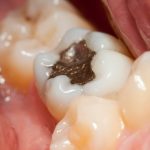DANGER in your mouth: The true risk linked to “silver” dental fillings
 (NaturalHealth365) Mysterious and talismanic, mercury (Hg) has long held the promise of power and curative effect. It’s an element commonly identified with the Greek Hermes, the fleet-footed messenger of the gods. In the 18th century, mercurial ointments were used as a treatment for syphilis, and by the 19th century dentists began using mercury almagam in dental fillings.
(NaturalHealth365) Mysterious and talismanic, mercury (Hg) has long held the promise of power and curative effect. It’s an element commonly identified with the Greek Hermes, the fleet-footed messenger of the gods. In the 18th century, mercurial ointments were used as a treatment for syphilis, and by the 19th century dentists began using mercury almagam in dental fillings.
However, mercury has been shrouded in controversy since the beginning, its toxic and harmful effects far outweighing any potential health benefits. In September, 2020, the U.S. Food and Drug Administration (FDA) released a long-overdue safety communication on amalgam, warning that pregnant women, children, and people with pre-existing conditions may be harmed by mercury dental fillings.
The root of the problem: What’s REALLY inside your dental fillings
A dental amalgam, which is often misleadingly referred to by the American Dental Association as a “silver filling,” is a mixture of mercury and a powdered alloy composed of silver, tin, and copper. Roughly 50% of dental amalgam is elemental mercury by weight.
Over the years, the dental amalgam releases small amounts of mercury vapor, and that vapor can lead to a host of unintended health issue as the mercury can accumulate in body fluids and tissues. The elemental mercury in dental amalgam can convert inside the body into toxic methylmercury, which is the same type of mercury that the FDA warns about in fish.
According to the FDA, the following groups are at high risk from dental mercury fillings:
- Pregnant women and their developing fetuses
- Women who are planning to become pregnant
- Nursing women and their newborns and infants
- Children, especially those younger than 6
- People with pre-existing neurological disease such as multiple scleroses, Alzheimer’s disease, or Parkinson’s disease
- People with impaired kidney function
- People with known heightened sensitivity (allergy) to mercury or other components of dental amalgam
Do NOT be mislead by the conventional dental industry
It took the FDA over a decade to warn the American people about the potential danger and risk of mercury fillings. In the meantime, in other parts of the world, including the Philippines, Ireland, Slovakia, Finland, Nepal, Moldova, Czech Republic and New Caledonia, amalgam phase-out dates and bans on amalgam use in children have long been underway.
To be clear, mercury is a neurotoxin. In fact, mercury poisoning is where the term “mad as a hatter” came from … in the 17th century, mercury was introduced in the process of hatmaking with life-threatening results to English hatters.
Think of it like this: If the amount of mercury in an average thermometer is put into a small lake, that lake will be shut down as an environmental hazard. Now, imagine the lake is your mouth.
What can you do? Advocate for mercury-free dentistry. And when it comes to you and your family’s safety, avoid going to a “regular” dentist who uses mercury-based, amalgam fillings.
The following organizations can help you find a mercury-free dentist:
- International Academy of Oral Medicine and Toxicology
- Consumers for Dental Choice
- Holistic Dental Association
Sources for this article include:



